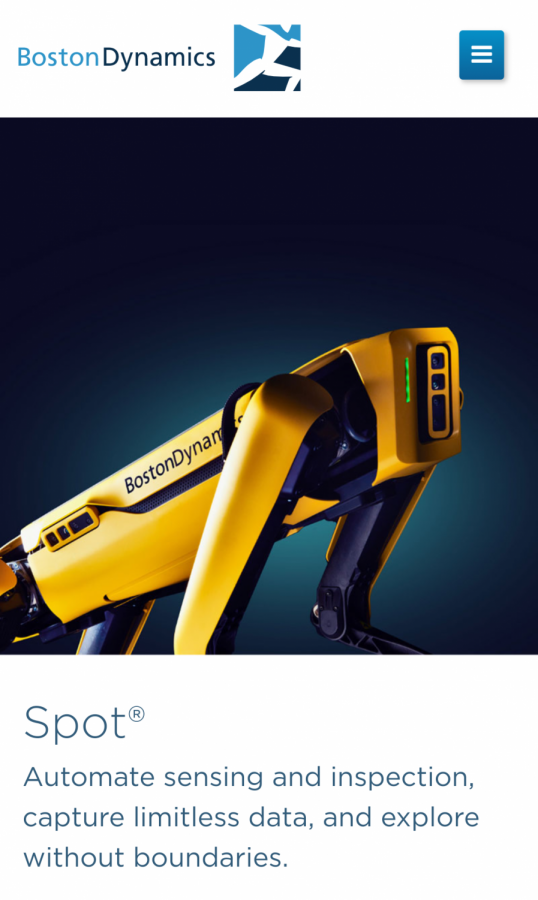Digidog: The Future of Surveillance?
Digidog is a robotic dog equipped with gears that make it perfect for surveillance missions. Critics fear that it may be used to breach privacy and threaten public safety.
An image of Spot as displayed in the Boston Dynamics website. Spot is a highly customizable product that can be modified for specific purposes.
In Ray Bradbury’s novel, Fahrenheit 451, the Mechanical Hound is an eight-legged robotic “dog” used to track down fugitives like the protagonist Montag. It represents the misuse of governmental authority and the corruption of technology. While Bradbury’s work depicts a fictional dystopian society, with the recent advancements in the fields of robotics and artificial intelligence, it has become possible for such “creatures” to jump out of picture books and into reality. With the latest addition of artificial intelligence to the list of NYPD used technologies, not everyone is convinced it will bring about positive changes.
The AI in question is dubbed as Spot®, a robot dog created by Boston Dynamics, an American engineering and robotics design company based in Waltham, Massachusetts. The robot is highly customizable, and is able to perform tasks in various fields, including construction, mining, manufacturing, and research. The robot used specifically by the NYPD weighs approximately seventy pounds, can run about three and a half miles per hour, and is equipped with cameras and lights that enable it to navigate through complex environments. Like many Boston Dynamics robots, it is very agile and versatile, enabling it to climb stairs, open doors, move objects, and engage in two-way communication.
Since the 1970s the NYPD has been using technology, such as ShotSpotter, GPS, and crime-pattern-recognition software, to assist officers during missions and investigations. As written in the NYPD website, the experimentation with new technology, such as Spot, is for “undergoing transformative technological change, implementing a number of initiatives that advance the Department’s ability to fight crime and keep the community safe.” The potential of the Digidog to perform surveillance and reconnaissance tasks in hostage situations and hazmat incidents can make it an invaluable addition. Digidog could improve the NYPD’s ability to address crimes, helping law enforcement officers get information they need without putting themselves in deadly or volatile situations. “This dog is going to save lives, protect people, and protect officers, and that’s our goal,” said TARU Inspector Frank Digiacomo, in an article published by ABC7 Eyewitness News.
However, critics worry that the deployment of advanced technologies like Spot would be ineffectively regulated by our current legislations and possibly cause social and political unrest. For example, an ACLU article warns that “the NYPD swept the [Digidog] technology into an overbroad category with other camera technologies” too carelessly. An event by MSCHF Product Studio went a step ahead by demonstrating the ease with which it can be weaponized. During the event, called Spot’s Rampage, the studio equipped Spot with a paintball gun and allowed the robot to wreak artistic havoc inside an art gallery. While Boston Dynamics has condemned such alteration of the robot, the possibility still exists, and with recent attention concerning police brutalities, weaponizing the Digidog has become a sensitive issue.

On Boston Dynamics’ side, point 5.2.2 of the Terms and Conditions regarding the sale of Spot states that “intentional use of the Equipment to harm or intimidate any person or animal, as a weapon, or to enable any weapon, (b) use or attempted use of the Equipment for any illegal ultra-hazardous purposes.” The company warns that if the guidelines are violated then the Warranty will be removed.
In addition, purchasing each robot can cost more than $70,000 even while excluding the cost of maintenance, making it one of the most expensive trial equipment used by the NYPD today. The U.S. Representative for New York’s 14th congressional district, Alexandria Ocasio Cortez, demanded in a February 2020 tweet that “these resources go to investments like school counseling instead.” She also questions: “when was the last time you saw next-generation, world-class technology for education, healthcare, housing, etc. consistently prioritized for underserved communities like this?”
To address this issue, New York City Council member Ben Kallos proposed what may be the nation’s first law banning police from owning or operating robots equipped with weapons. This bill would expand on the Public Oversight of Surveillance Technology (POST) Act, which requires the police department to ensure oversight and transparency by disclosing their use of surveillance technology. However, the bill is not directed at unarmed utility robots like the Digidog, only weaponized robots.
Despite this controversy, Spot has already been deployed in a real life mission. In a Bronx home invasion, the Digidog was sent into the building to investigate a potential hostage situation after two men were threatened at gunpoint and tied up by two other men. The robot later determined that no one was inside, allowing police officers to enter the building. The robot also came in handy in Queens, where two armed men were holding five hostages in a home, and in Brooklyn, where a gunman barricaded himself inside a home.
Technology is quite often implemented before political and legal systems can adjust to its impacts. While it is unlikely that Spot will become a nightmare out of Bradbury’s Fahrenheit 451, we must be responsible for handling its future developments. Ultimately, the purpose of Digidog is to improve our lives, not to oppress us.
The potential of the Digidog to perform surveillance and reconnaissance tasks in hostage situations and hazmat incidents can make it an invaluable addition. Digidog could improve the NYPD’s ability to address crimes, helping law enforcement officers get information they need without putting themselves in deadly or volatile situations.
Samia Sultana is a News Editor for 'The Science Survey’ who believes that journalistic writing and photojournalism shed light into the hidden corners...

